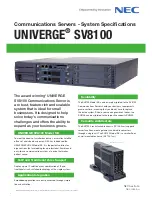
Replacing optional internal USB memory key
Prerequisites
CAUTION:
To avoid interference with other components in the server, the maximum permissible dimensions of the USB memory
key are 15.9 mm wide x 57.15 mm long x 7.9 mm high.
1
Follow the safety guidelines listed in
2
Follow the procedure listed in
Before working inside your system
.
3
If installed, remove the low profile expansion card riser.
Steps
1
Locate the USB port or USB memory key on the system board.
To locate the USB port, see the Internal USB memory key (optional) section.
2
If installed, remove the USB memory key from the USB port.
3
Insert the replacement USB memory key into the USB port.
Next steps
1
If removed, install the low profile expansion card riser.
2
Follow the procedure listed in
After working inside your system
.
3
While booting, press F2 to enter
System Setup
and verify that the system detects the USB memory key.
Optical drive (optional)
Optical drives retrieve and store data on optical discs such as CD and DVD. Optical drives can be categorized into two basic types: optical
disc readers and optical disc writers.
Removing the optical drive
Prerequisites
1
Follow the safety guidelines listed in
2
Follow the procedure listed in
Before working inside your system
.
3
Disconnect the power and data cables from the connectors on the optical drive.
NOTE:
Ensure that you note the routing of the power and data cable on the side of the system as you remove them
from the system board and drive. Route these cables properly when you replace them to prevent them from being
pinched or crimped.
Steps
1
Press the release tab to release the optical drive.
2
Slide the optical drive out of the system until it is free of the optical drive slot.
3
If you are not adding a new optical drive, install the optical drive blank. The procedure to install the optical drive blank is the same as
the optical drive.
146
Installing and removing system components
















































